Alleviation: An International Journal of Nutrition, Gender & Social Development, ISSN 2348-9340
Volume 5, Number 5 (2018):
© Arya PG College, Panipat & Business Press India Publication, Delhi
www.aryapgcollege.com
Role of Women in Decision-Making Related to Farm Activities: A Case Study of Fatehabad and Jind District of Haryana State
1. Varsha Rani* 2. Renu Boadlia & 3. Meenakshi Chaudhary
1. Assistant Professor, Department of Economics
2. Assistant Professor, Department of English
3. Assistant Professor, Department of Economics
Arya PG College, Panipat, Haryana, India
*Email: rajvarsha14@gmail.com
Introduction
Agriculture is an engine of growth of poverty reduction in developing countries where it is the main occupation of the poor segment of the society. A woman makes essential contribution to the agricultural sector and rural economy in developing countries. Agriculture in India contributes about 13 per cent of GDP and is predominately a female activity. The dairy and animal husbandry sector of agriculture is totally dependent upon the women workforce. Almost all the women in rural areas can be considered as farmers in some senses as almost all of women are directly or indirectly engaged in agricultural activities such as agricultural laborers, working at the own farm and in dairying and animal husbandry etc. As majority of the agricultural workers in the country comprises of the women, their roles in the decision making in different agricultural activities need to be properly looked into. Decision-making is a basic process that underlines all functions of the family and resource management. Rural women share abundant responsibilities and perform almost all duties in running the family, maintaining the households and attending widely various farm activities in rural areas. In spite of performing all these activities, her involvement in agricultural decision making process specially crop production and money matters is very low as compared to men in rural areas. Women play an important role in control and supervision of farm production, horticulture, livestock and other productive work in agricultural sector. Despite women’s critical contribution to the family income through productive activities, the recognition is not given to the women because of many social and economic factors which ultimately effect the women’s contribution in agricultural sector. The overview of some of the studies in India showed considerable variation in women’s involvement actively in decision making process in different parts of the country, especially in rural areas. The growing state like Punjab, Haryana and Uttar Pradesh show positive and slightly active role of women in decision making process in rural areas but in low income states, the pattern of participation in decision is traditional where head of the family make all the decisions related to family as well as agricultural related activities. In rural areas, many factors like economic conditions of the family, age, education, farm size, husband’s income, family size and number of male workers in the family and their employment status affect the involvement of women in decision-making. Besides this, women’s involvement become negligible where the decisions increase in complexity in rural areas due to illiteracy of women. So keeping in view the above facts, an attempt has been made to explore the extent of rural women's participation in decision- making in different activities in agricultural and livestock management in district Jind and Fatehabad of Haryana state and the affects of selected main factors in decision making of the women’s participation in the study areas.
Methodology
For achieving the specific objectives of the study, two districts have been selected purposively (Jind and Fatehabad) on the basis of the ratio of highest working population of women in agricultural sector in Haryana. Two blocks were taken randomly from each district i.e. Jind and Fatehabad. Narwana and Uchana blocks were selected from the district Jind. Bhattu Kalan and Ratia blocks were taken from district Fatehabad A total of eight villages, two from each block, have been selected. Villages Dhakal and Esmilpur have been selected from Narwana block and Karsindu and Dumarkha kalan have been selected from Uchana block of district Jind and Villages Jandvala Bagar and Dhaier have been selected from Bhattu kalan block and Fulkan and Alika have been selected from Ratia block of district Fatehabad.
In the study, total 400 respondents were selected to collect the required information for fulfilling the stated objectives through using simple random sampling. Hundred respondents/ sample households from each block (50 from each village) were taken into-account from eight villages of both districts. The research participants belonged to agricultural families and were above 18 years age.
Most of the interviews were conducted in the homes and at the work place. Notes were taken based on the loosely structured questionnaires. Detail of sample blocks and villages of both the districts is presented in Table 1.

Estimation Technique: Ordinary least square (OLS) multiple regression method has been used to examine the effect of selected factors on women participation in agricultural sector. A detail of variables and estimated model is as under:
WP(Y) = Bo+ B1 X1 + B2 X2 + B3 X3 +B4 X4 + B5 X5 +………Bn Xn + U
WP(Y) =Women participation
B0 = Intercept
X1 = Age
X2 = Education
X3 = Income
X4 = Farm Size
X5 = Husband occupation
X6 = No of male workers in the family
X7 = Family Size
U = Error Term or residual value
Results and Discussion
Women Participation in Decision-Making Related to Crop Production Activities
The results regarding women participation in decision related to crop production process are presented in Table 2.
Table 2 depicted that above 87.5 per cent of the women used to play negligible role in the decision making regarding the allocating of area under different crops along with another 10 per cent who had joint role in the same activity in both districts as well as for the whole state. This may be due to the fact that women are more active and participative in the helping activity and the core crop cultivation activity was managed by men only in agricultural sector. In case of decision making regarding the machines to be used during production process, 75.3 per cent of the decisions were taken by men independently in the study areas. Only 9.5 per cent in Fatehabad, 38 per cent in Jind district and 23.7 per cent decisions were taken jointly in Haryana state which might be because of the educated families in rural areas. The results further depicted the role played by women in the decision making relating to selection of variety of seeds to be used for crop production. As is clear from the Table 1, majority of the female respondents played no role in the process. This may be due to the fact that selection of variety of seeds for production of crops depending on past experience with the products, males had better knowledge in this regard, another 13.7 per cent used to play joint role in decision-making process in this issue. In case of use of manures and fertilizers, it is clear from the table that more than majority of respondents were excluded from this process, 13 per cent used to play a joint role in taking decision regarding
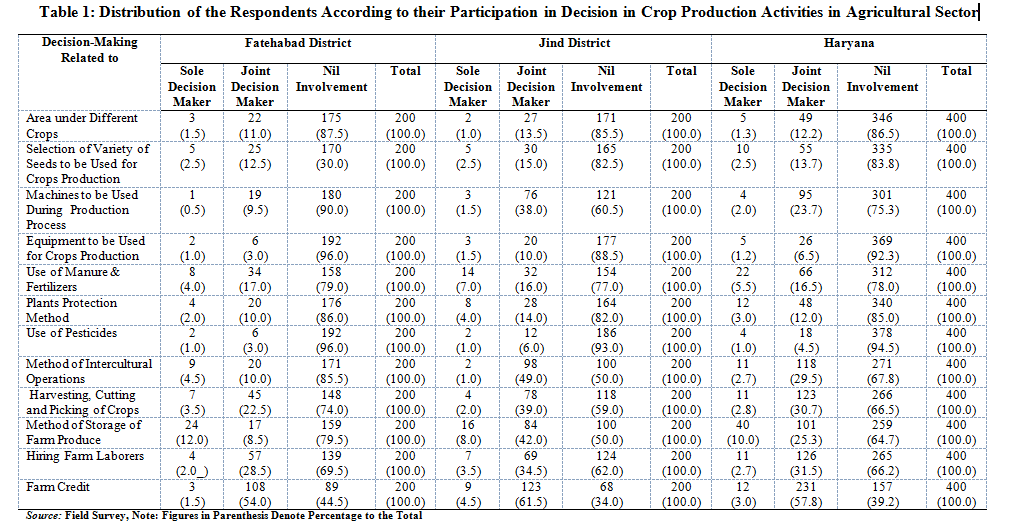
the use of manures and fertilizers for crops production. Remaining 5.5 per cent respondents had been found to be major decision makers in use of manure and fertilizes in Haryana state. Hence, women has little role in the decision making process regarding the selection of manures and fertilizers for crop production in agricultural sector. Further, the role of women in method of intercultural operations was also very low and it was found that 67.8 per cent of the respondents had no role in taking decisions regarding the method of intercultural operations. In case of harvesting, cutting and picking of crops, 66.5 per cent of women had no role along with 30.5 per cent decided jointly regarding the same process. Another 2.8 per cent had no role in taking decisions in harvesting, cutting and picking activities in Haryana state. Further, in decisions regarding the method of storage of farm produce, it was found that 25.3 per cent had been taken jointly in Haryana state and 64.7 per cent of the respondents had no involvement under this activity. It can be concluded that most of the decisions regarding crop production activities had been taken by men in agricultural sector. The data had shown a very depressed picture of decision making power of women in Jind as well as in Fatehabad districts. During crop production process, women play a pivotal role at farm but it is unfortunate that their role and contribution has not been recognized in decisions related to crop production activities in agricultural sector. In addition to this, due to low education level and lack of information about technologies, rural women face relative isolation in decision-making. So there is a need to take some effective steps to ensure active participation of women in taking decisions in agricultural sector.
Role of Women in Decision-Making in Buying and Selling Activities
Women participation in decision making in buying and selling activities in agricultural production in Jind, Fatehabad districts and Haryana State has been shown in Table 3
The figures in Table 3 depicted that in purchase and sale of land, 69 per cent of respondents had no role in taking decisions in Fatehabad district, followed by 63 per cent in Jind district only , 29.5 per cent in Fatehabad district and 32.5 per cent of Jind district reported that they had taken joint
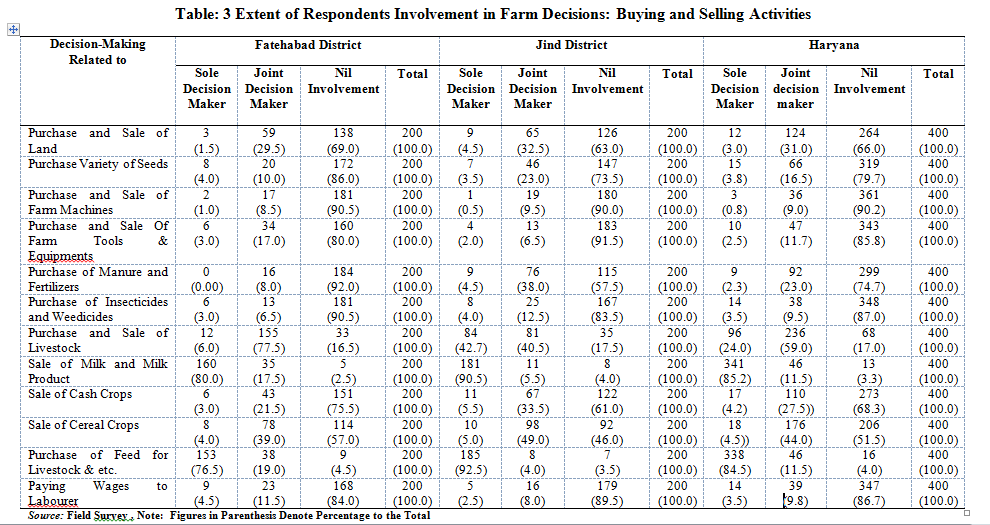
decision with regards to purchase and sale of land. In case of purchase and sale of farm machines, only 16.5 per cent of respondents accepted that they had a role and more than 90 per cent of the respondents accepted that they had no role in taking decision in both districts as well as for the state. In case of purchase of insecticides and weedicides, women had a very small role in the decision-making process as only 9.5 per cent respondents had opinioned that they had taken joint decision in this process. More than 77.5 per cent of the respondents had been found to play an equal role in taking decisions relating to buying and selling of livestock in Fatehabad district and 42.7 per cent of respondents in Jind district reported that they had taken decisions independently. Hence, women had a very active participation in taking decisions with respect to buying and selling of livestock. In case of sale of milk and milk products, most of the decisions had been taken by women in both districts as well as in Haryana state, because all activities were performed by the women. The data also revealed the picture regarding the role played by women in purchasing feed for livestock. The results indicated that 75 per cent of decisions had been taken independently by women in both of the districts. It can be concluded that women had no active participation in respect of farm buying and selling activities. Most of the decisions had been taken by men or jointly. But in case of livestock activities, most of the decisions had been taken by women independently or jointly in rural area.
Role of Women in Decision-Making Related to Expenditure on Farm Activities
It can be seen from the Table 4 that there was nil involvement of women in major decisions related to amount of money to be spent on the purchase of machine. It has been found that only 1 per cent of the respondents had sole decision-making in case of the money to be spent for purchase of seeds in both districts as well as Haryana state, respectively. The position of women once again had accepted the fact that they had not been able to convert their views into final decision regarding money to be spent on purchase of implements.
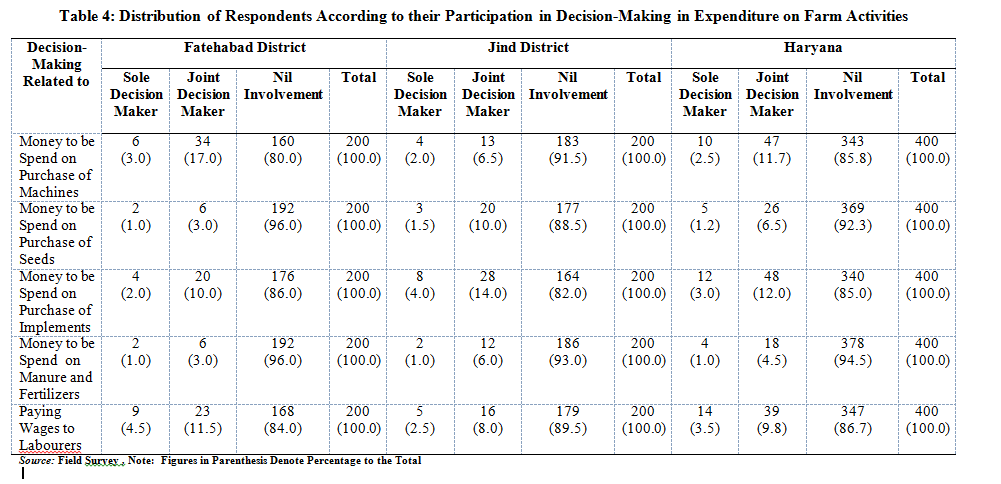
The reason behind was that these activities were performed traditionally by men and they had better experience as compared to women in purchasing implements. In case of money to be spent on manures and fertilizers, the most of the respondents reported that they were not been involved. It may be due to the fact that most of the application activities were performed by the males in agricultural sector, so they had better knowledge as compared to women. The similar results had been found in decision making related to paying wages to laborers as only 3.5 per cent of respondents had accepted the fact that they had been able to convert their views into final decisions. Same picture had been emerged for the selected districts as well as for the state. It was suggested on the basis of the results that there is an urgent need to motivate the females to have the accurate knowledge about their technical and legal rights. The high level of education and workshops, extension lectures can work for the betterment of women in the direction of increasing the decision making power of females in the selected region.
Constraints Faced by the Women in Taking Decision in Agricultural Sector
It can be visualized from Table 5 that most of the women agreed or strongly agreed to the fact that literacy level, economic, political and legal literacy were the major constraints faced by them in rural areas. If women would get proper education, then they would be able to make their voice heard in all sections of the society. Lack of social interaction and cultural constraints had greater effects on the women’s decision-making power in agricultural sector of both districts of Haryana state.
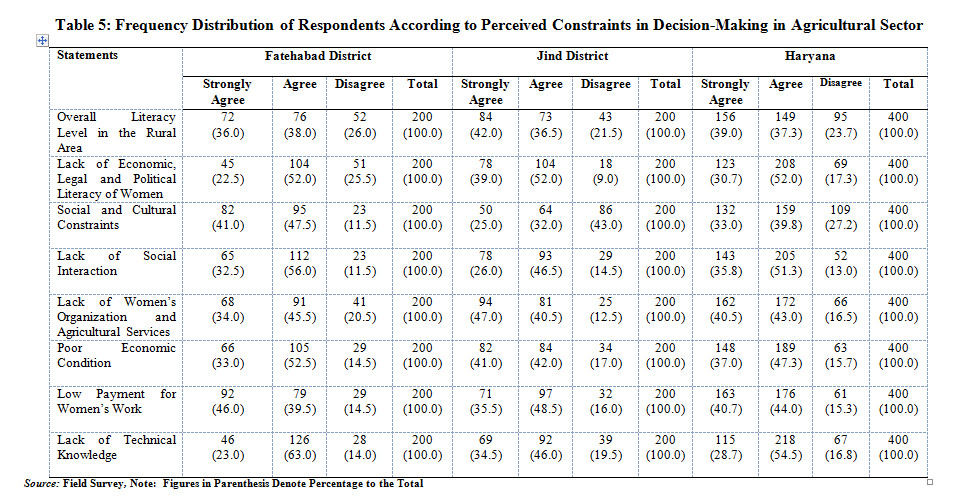
Above 80 per cent of women agreed to the fact that due to lack of interaction and social and cultural tradition of the family, they were not able to take decisions independently in the family. Lack of women’s organization and agricultural services were also major obstacles in taking decision by women in agricultural sector, 60 per cent of respondents were of the view that they were deprived because of low payment for the same work in agricultural sector. This arise from the fact that agricultural extension services in Haryana has traditionally been focused on men and their farm production needs, while neglected the females work as compared to their counterparts. So there is an urgent need to take effective steps for the welfare of the women in agricultural sector. It is also found that 37 per cent of respondents had strongly agreed and another 47.3 per cent agreed with the statement that poor economic conditions of the women has highly affected the decision-making power of women in agricultural sector. Low payment of women’s work and lack of technical knowledge has greater influence on women for taking decisions in agricultural sector in Haryana state. It can be concluded from the table that there is a strong need of women’s sagacity of self esteem; their right to determine choices according to their point of view and their right to have access to opportunities, prospects and resources regarding basic amenities of life.
Above analysis concluded that women play a leading role in agricultural sector. Apart from this, they make a significant contribution to food production and processing but in decision-making process, men seem to make more of the farm decisions and control the production resources in agricultural sector. Women have greater participation in decision making in routine work especially in home based activities. But recognition of women decision-making power in agricultural farm operations has remained a major concern for the women’s participation and their development in the agricultural sector. The males dominate in majority of the farm decisions related to crop production activities, buying and selling activities, expenditure and opting measures for increasing production activities in agriculture sector. Women play a significant role in livestock farming but their control over livestock is very minimal. The income from animal does not remain in the hands of women and neither does the decision regarding sale and purchase of livestock. So there is an urgent need to develop technologies which will help the women to carry out the activities in agricultural sector and farm women have to be motivated to acquire more scientific knowledge for increasing their decision-making in agricultural sector.
Effect of Selected Factors on Decision-Making of Rural Women in Agricultural Sector
To examine the effects of selected variables on women’s contribution in agricultural sector, regression analysis was used.
Co-efficient of correlation matrix of selected socio-economic variables of Haryana state: It can be visualized from Table 6 that there was no high correlation among all the explanatory variables. Most of the variables in regression analysis were not highly correlated. So the results showed that there was absence of multicollinearity in the regression analysis. The figures in the Table 6 also shows the mean value of all variables with standard deviation. The mean value of respondent’s age was 35.8, maximum 78 years and minimum 15 years and deviation of age from age mean was 10.61. The mean value of respondent’s education was 7.59 and 5.04 Standard Deviation. The mean value of family income was 4.11 with 1.24 standard deviation. The average farm size was 7.56 and deviation from mean value was recorded as 5.47. The average husband income was 1.69 lakh and the value of standard deviation was 1.32. The mean value of family size was noticed as 5.36 and 1.46 standard deviation.
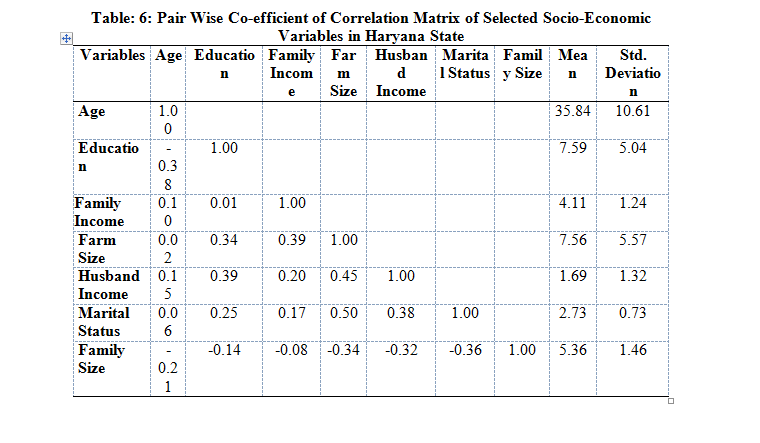
Coefficients of selected socio-economic variables of regression analysis of Haryana state: It can be seen from the Table 7 that the women participation and all predictor’s variables were directly related to each other. The coefficients of all variables were found to be statistically significant. The largest values of beta coefficient (-0.352 and -0.418) were found to be statistically significant at 1 per cent level of significance in case of husband’s income and farm size. These variables made strong contribution in regression analysis. Partial correlation between women participation and husband’s income was 0.48, followed by 0.40 with respect to farm size. Beta value of these variables indicated that participation of women in agricultural activities had decreased with the increase of farm size and husband’s income. The co-efficient of age had been found to be negative and statistically significant at 1 per cent level of significance. It means that the increase in one year age reduced the women’s participation in agricultural sector at -0.12. The results showed that the impact of education on rural women participation had been found to be negative but statistically significant. The partial correlation between education and women’s participation was -0.230. It meant that education had negatively affected the women participation in agricultural sector. Respondents’ marital status or family size was also significant. The beta value of marital status explained that married women had effectively participated in agricultural sector as compared to unmarried women. In case of family size, beta value showed that with the increase of one unit of family size, the women participation had been increased with 0.148.
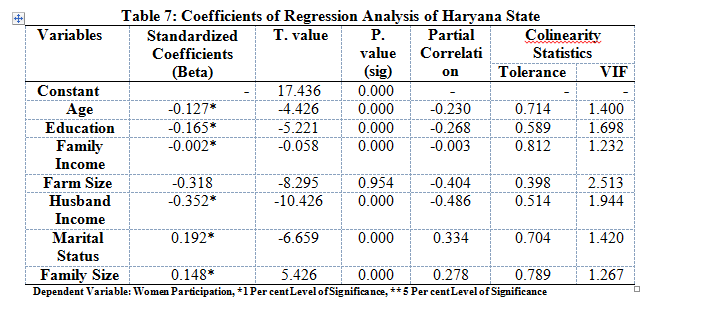
Partial correlation of farm size with women participation was 0.278. Household income had no significant impact on women participation in agriculture sector in regression analysis. From the results, it can be explained that there had been no association between women’s participation and household income. The tolerance value was less than 0.10 and variance inflation factors above 0.10; therefore it had not violated the multicollinearity assumptions.
Regression analysis summary of selected socio- economic variables of Haryana state: It can be seen in the Table 8 that the R value had been found to be 0.891, that showed there was an overall strong relationship between the selected dependent and independent socio economic variables in Haryana state. The value of R square was 0.794 and therefore, it can be interpreted that the independent variables could cover 79.4 per cent of the variance in participation of women in agricultural sector.

From the above analysis, it can be concluded that all the socio-economic factors had affected the women participation in agricultural sector in Haryana state. The variables; age, education, farm size, household income and husband income were negatively affecting the women participation in agricultural sector. But family size and marital status of the respondents were positively associated with women participation in agricultural sector. The women living in joint families were more likely to participate in the agricultural sector than those who were living in small as well as in nuclear family. Some of the variables had positive and some had insignificant impact on women participation. The result showed that one of the major reasons for the women labor supply was financial constraints as indicated by variable-source of income. Some families did not allow their women to go outside the homes especially for work purpose. Therefore, in order to make women socially and economically sound, interest free micro finance along with free training of various economic activities such as poultry farming, agricultural activities etc. should be provided so that they could be capable to increase family income as well as country’s development.
Conclusions
On the basis of the study, it can be concluded that the women’s participation as a planner in the agriculture sector of the district Jind has not been recorded up to the mark. So, some steps should be taken to upgrade the role of women in decision-making in agriculture sector.
• There should be improvement in women’s access to basic economic resources such as land, technical knowledge, credit and agricultural innovations.
• The educated women from the rural areas should be involved in the training programme, workshops to motivate the rural agricultural women for enhancing their roles in participation on the farm.
• Empowering women for participation in agricultural decision-making and leadership in district Jind represent the most appropriate and effective way of forwarding them.
• Support system of women farmers within holistic gender- sensitive framework were urgently needed to form a policy development and implementation agenda. Women must be directly involved in the development and implementation of the new technology.
References
Alagumani T (1999) A Study on Decision Behavior of Rural Women in Madurai District, Tamil Nadu. Indian Journal of Agricultural Economics 54 (3): 300.
Ali MM and Ahmad N (1983) Role of Women in Rice Farming in Pakistan. Islamabad Pakistan Agriculture Research Council (PARC).
Arayesh MB (2017) The Relationship between Extension Educational and Psychological Factors and Participation of Agricultural Co-Operatives' Members. International Journal of Agricultural Management and Development 7 (1): 79-87.
Arya K (1964) Women’s Role in Decision Making in Farm and Credit Utilization. Thesis Abstract, Haryana Agriculture University, Hissar, India.
Awan MS, Farooq SU and Bilal RU (2008) Educational Attainment, Occupational Choice and Poverty: A Gender Perspective from Pakistan. Journal of Managerial Sciences 2 (1): 45-40.
Azid T, Aslam M and Chaudary MO (2001) Poverty, Female Labour Force Participation, and Cottage Industry: A Case Study of Cloth Embroidery in Rural Multan. The Pakistan Development Review 40 (4): 1105-1118.
Badiger AG (1999) Participation of Women in Comparison with Men in Agriculture and Allied Activities. MSc Thesis. Univ. Agric. Sci. Dharwad, India.
Bala N (2010) Selective Discrimination Against Women in Indian Agriculture-A Review. Agricultural Reviews 31 (3): 224–228.
Baliyan K and S Kumar (2014) Contribution of Farm Women in Household Income: Evidence from Western Uttar Pradesh. Journal of Managerial Sciences 2 (1): 113-118.
Balla H (2007) Impact of National Rural Employment Guarantee Scheme on Rania Block of District Sirsa (Haryana). MPhil Thesis, Department of Economics, University Centre for Distance Learning, Chaudhry Devi Lal University, Sirsa.
Bano S, Faridi, MZ and Bashir F (2012) Rural Women’s Contribution in Family Budget: A Case Study of District Layyah. Journal of Economics and Sustainable Development 3 (10): 1-9.
Batra U (2007) Analysis of Rural Employment Generation Programmes in District Mahendergragh (Haryana). M. Phil Thesis, Department of Economics, University Centre of Distance Learning, Chaudhary Devi Lal University, Sirsa.

